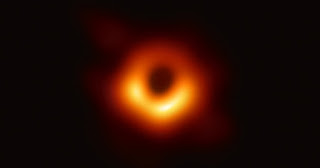Astronomers reveal the first-ever picture of a black hole
On April 10, 2019, in coordinated press conferences
around the world, researchers unveiled the first direct visual evidence – a
photo, albeit in the “light” of radio waves – of a supermassive black hole.
This is the result of a multi-year, international collaboration. The
astronomers said it presents “paradigm-shifting” observations of the gargantuan
black hole in the center of the galaxy M87, 55 million light-years from Earth.
The image doesn’t show the black hole itself; black holes are black because no
light can escape them, and thus the holes themselves are invisible. Instead,
what astronomers are calling the black hole’s “shadow,” a bright ring formed as
light bends in the intense gravity around the hole. This black hole, by the
way, at M87’s heart, is thought to be some 6.5 billion times more massive than
our sun.
To obtain the image, astronomers used the Event
Horizon Telescope – a planet-scale array of eight ground-based radio telescopes
– designed specifically to capture the first-ever black hole photo.
This breakthrough was announced April 10 in a series
of six papers published in a special issue of The Astrophysical Journal
Letters. To say it is a big deal for astronomers is an understatement. Although
black holes have been studied for decades, they’ve been largely theoretical
objects. All the images you’ve ever seen of them have been computer simulations
or artist’s conceptions, until now.
Black holes are extraordinary cosmic objects with enormous
masses but extremely compact sizes. The presence of these objects affects their
environment in extreme ways, warping spacetime and super-heating any
surrounding material.
Multiple calibrations and imaging methods revealed a
ring-like structure with a dark central region – the black hole’s shadow – that
persisted over multiple independent EHT observations.
Supermassive black holes are relatively tiny
astronomical objects – which has made them impossible to directly observe until
now. As a black hole’s size is proportional to its mass, the more massive a
black hole, the larger the shadow. Thanks to its enormous mass and relative
proximity, M87’s black hole was predicted to be one of the largest viewable
from Earth – making it a perfect target for the EHT.
The shadow of a black hole is the closest we can
come to an image of the black hole itself, a completely dark object from which
light cannot escape. The black hole’s boundary – the event horizon from which
the EHT takes its name – is around 2.5 times smaller than the shadow it casts
and measures just under 40 billion kilometers [25 billion miles] across.
The Event Horizon Telescope links telescopes around
the globe to form an Earth-sized virtual telescope. Its Earth-sized scale gives
it sensitivity and resolution that’s truly unprecedented: hence, the first-ever
black hole image. The EHT is the result of years of international
collaboration. It offers scientists a new way to study the most extreme objects
in the universe predicted by Einstein’s general relativity during the
centennial year of the historic experiment that first confirmed the theory.
Breakthroughs in technology, connections between the
world’s best radio observatories, and innovative algorithms all came together
to open an entirely new window on black holes and the event horizon.
And, as with all new advances in science, this new
step forward is sure to lead to more questions! Astronomers and astronomy enthusiasts
are already asking them.



Comments
Post a Comment